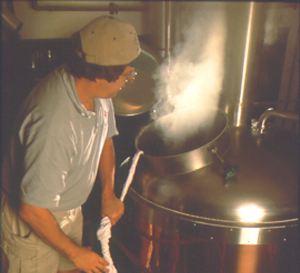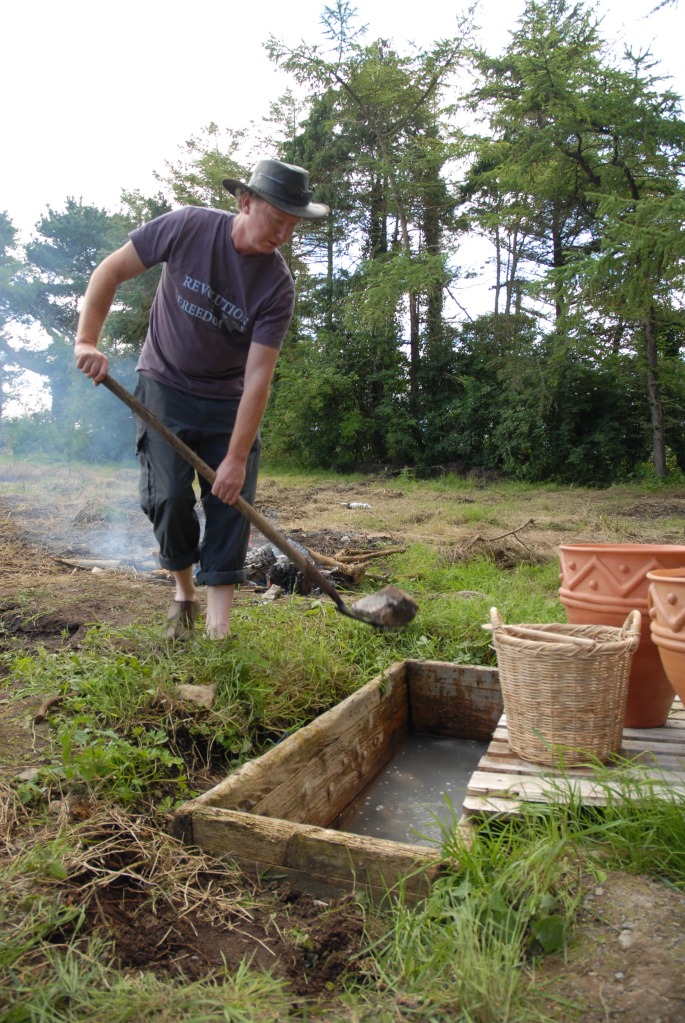Dining and Dwelling part 2
Part two of Dining and Dwelling publication (Part one here)
THE GREAT MYSTERY OF PREHISTORIC BREWING.
In prehistoric times until the late Iron Age, metallurgy was limited to small hand tools and high-status items. Throughout prehistoric Europe one of the main challenges for the brewer (in the absence of suitable metal containers) was heating large volumes of water to make a wort (see below). Indeed, given that brewing until the modern era was a home-based industry, sufficiently large metal mash tuns (watertight containers) were uneconomical. So how could people brew without the application of direct heat? Hot rocks are the most logical means.
A simple web search gave us some quick answers. Today the only commercial hot-rock brewery in the world (as far as we know) is Boscos Brewery in Nashville. Here the master brewer uses Colorado Pink Granite to heat the mash. The stones are heated in a brick oven and added to the mash – in a process known as decoction, whereby the temperature is gradually raised over a period of time. Further evidence of hot rock brewing comes from Finland where Sahti, a vernacular unhopped ale is still served at rural feasts. Again the ale is prepared by immersing hot rocks into a wooden mash tun; the resulting wort is then flavoured by filtering it through juniper branches. The brewing of Sahti has been traced back over 500 years. Although Sahti is specifically linked to Finland, ales using similar brewing methods were brewed throughout the Baltic States and as far south as Ossetia in modern Georgia.

Boscos Head Brewer and Founding Partner Chuck Skypeck brews Stone Beer
With so many comparative ancient and contemporary processes involving pits in the ground or wooden troughs and hot-rock brewing technology, the not unreasonable conclusion we reached was that fulachta fiadh would make ideal micro-breweries.
SO HOW DO YOU BREW A PREHISTORIC BEER?
Beer at its simplest requires the following ingredients : milled, malted grain (preferably barley but wheat will do), copious amounts of reasonably clean water, yeast to aid fermentation and herbal flavouring. The latter ingredient is not an essential component in brewing but traditionally bitter tasting, dried leaves were added to counter the sweetness of the brew and increase palatability. At the processing stage the conditions and equipment required are a preparation area for malting (an aired, indoor floor space where the saturated grain can be dried and lightly roasted), firewood for heating stones, a large, watertight wooden container or mash tun, a paddle for stirring and some earthenware fermentation vessels.

The fundamentals of brewing necessitate converting the starch in the malted grains into soluble sugars. This is achieved by adding the milled, malted grain into a container of hot water heated to a temperature of approximately 67°C. This mix is then mashed or agitated using a paddle producing a glucose-rich syrupy solution known as a wort. The wort is then transferred into storage vessels where the yeast and flavourings are added and allowed to stand for several days where fermentation will naturally occur. During this stage the brew begins to fizz and froth as the active yeast devours the sugars and excretes alcohol. When the fizzing subsides the fermentation is complete and the end product is unhopped ale.
Hot-rock technology has been used by primitive communities throughout the world and involves heating fist-sized stones in a fire, removing them with a tongs or a fork and then dropping them into a water vessel. In a brewing context this process became known in Germany as ‘stein beer’ (stone beer). Indeed up until recently Rauchenfels Brewery in Marktoberdorf, Bavaria, revived this tradition by using heated Graywacke to make their own distinctive beer. This dark sandstone resists shattering under the stress of super heating and is quick to cool—ideal for brewing. A beer reviewer had this to say about their product:
‘The use of stones imparts wonderfully smoky, toffeeish notes to Steinbrau. When the hot rocks are added to the brew kettle (which is made from metal these days), some of the malt sugars will be caramelized right onto the stone surface. The stones, heated in a beechwood fire, will impart their own smokiness to the beer.’
NEXT POST: OUR BREW
This entry was posted on Wednesday, September 16th, 2009 at 12:42 pm. It is filed under About Archaeology, About the Beer, Fulacht fiadh and tagged with ancient beer, Dining and dwelling, Fulacht fiadh, National Roads Authority, NRA.
You can follow any responses to this entry through the RSS 2.0 feed.







Hello there,
Good blog, I just stumbled upon it and I’m already a fan.